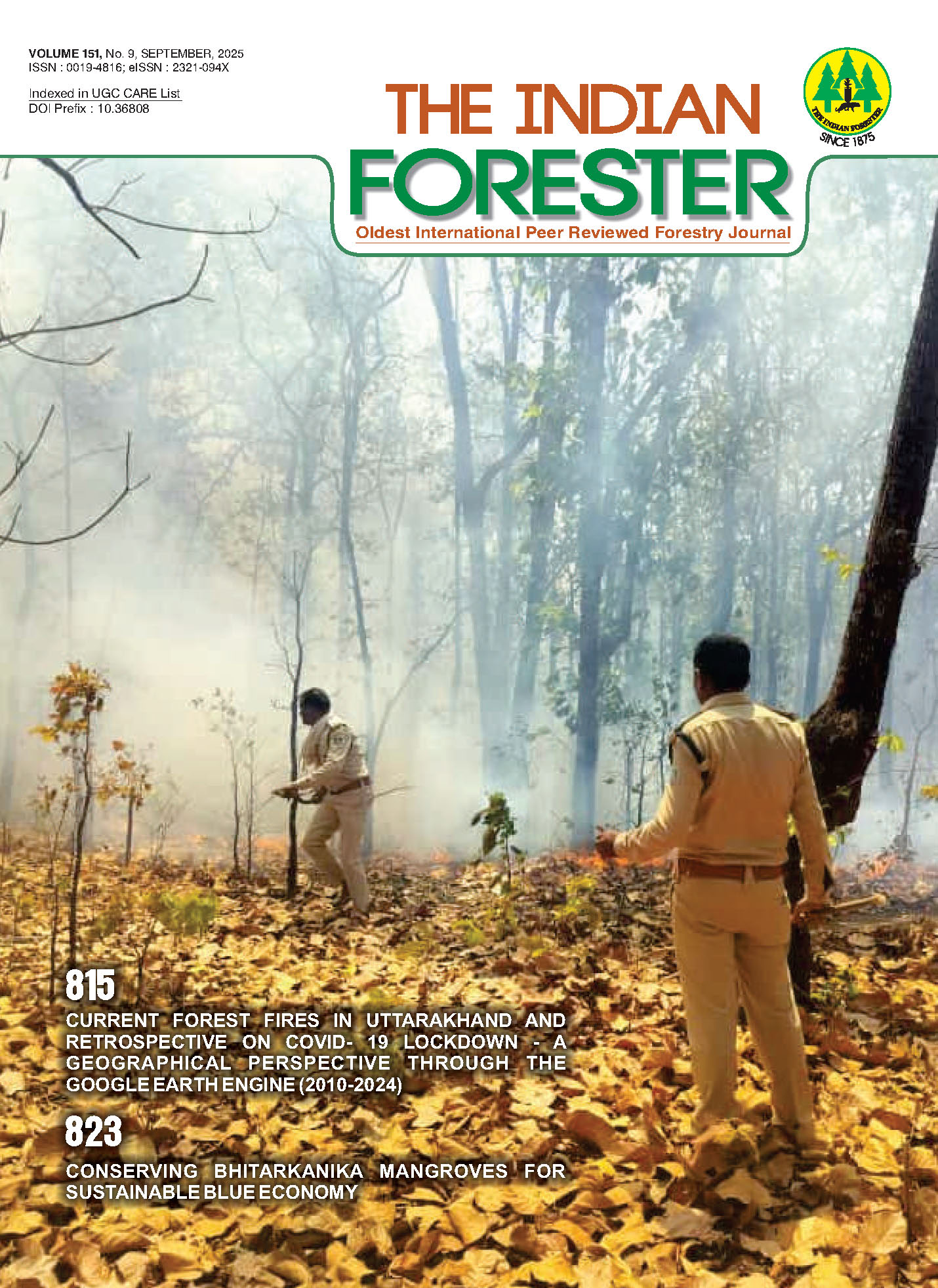Fruit and Seed Morphological Characteristics of Selected Forest Tree Species of Family Anacardiaceae of Kotdwar, Uttarakhand, India
DOI:
https://doi.org/10.36808/if/2025/v151i9/170759Keywords:
Fruit morphology, Seed morphology, Moisture content, Kotdwar region.Abstract
This study investigates fruit and seed morphology variations among five Anacardiaceae species: Spondias pinnata, Semecarpus anacardium, Buchanania lanzan, Lannea coromandelica, and Pistachia khinjuk, to understand their ecological adaptations. Fruit traits examined include weight, length, width, pulp weight, and moisture content, while seed traits encompass weight, length, width, moisture, and 1000-seed test values. Spondias pinnata produced the largest fruit (208.14 g, pulp 119.34 g, moisture 72.46%), whereas Pistachia khinjuk had the smallest (2.27 g, pulp 0.53 g). For seeds, Spondias pinnata had the heaviest (88.71 g for 10 seeds) and highest 1000-seed value (8292.94), while Pistachia khinjuk had the lightest (1.02 g for 25 seeds) and lowest test value (43.21). Seed moisture content ranged from 41.17% (Lannea coromandelica) to 61.66% (Spondias pinnata). These variations reflect different ecological strategies and reproductive adaptations, highlighting the potential for these species in agroforestry, conservation, and restoration efforts. The findings emphasize the importance of conserving these species for ecosystem health and their application in horticulture. Further research should explore genetic and environmental influences on these traits.
References
Adewale B.D., Kehinde O.B., Aremu C.O., Popoola J.O. and Dumet D.J. (2010). Seed metrics for genetic and shape determinations in African yam bean [Fabaceae] (Sphenostylis stenocarpa Hochst. Ex. A. Rich.) harms. African Journal of Plant Science, 4(4): 107–115.
Alfaro A., Rodríguez M. and Morales J. (2018). Fruit morphological traits and adaptation of Pistachia species in arid environments. Journal of Arid Land, 10(3): 175-182.
Cervantes E., Martín J.J. and Saadaoui E. (2016). Updated Methods for Seed Shape Analysis. In Scientifica (Vol. 2016). Hindawi Limited. https://doi.org/10.1155/2016/5691825
Chandra Naithani S. (2004). SC Naithani, R Naithani, B Varghese, JK Godheja, KK Sahu, M Sacandé, C Jøker Comparitive Storage Biology of Tropical Tree
Adewale B.D., Kehinde O.B., Aremu C.O., Popoola J.O. and Dumet D.J. (2010). Seed metrics for genetic and shape determinations in African yam bean [Fabaceae] (Sphenostylis stenocarpa Hochst. Ex. A. Rich.) harms. African Journal of Plant Science, 4(4): 107–115.
Alfaro A., Rodríguez M. and Morales J. (2018). Fruit morphological traits and adaptation of Pistachia species in arid environments. Journal of Arid Land, 10(3): 175-182.
Cervantes E., Martín J.J. and Saadaoui E. (2016). Updated Methods for Seed Shape Analysis. In Scientifica (Vol. 2016). Hindawi Limited. https://doi.org/10.1155/2016/5691825
Chandra Naithani S. (2004). SC Naithani, R Naithani, B Varghese, JK Godheja, KK Sahu, M Sacandé, C Jøker Comparitive Storage Biology of Tropical Tree Seeds.academia.edu.
Das A., Kumar P. and Singh R. (2017). Seed traits and ecological adaptations of tropical species: A case study of Spondias pinnata. Tropical Ecology, 58(2): 325-335.
Esau K. (1977). Anatomy of seed plants. John Willey & Sons, Inc. Canada, ISBN:0471022519.
Gremillion K. (1993). The evolution of seed morphology in domesticated chenopodium: an archaeological case study. In Ethnobiol, 13 (2).
Hill A.W. (1933). The method of germination of seeds enclosed in a stony endocarp. Annals of Botany, 47: 873–887.
ISTA (2010). International rules for seed testing. International Seed Testing Association (ISTA), Zurich, Switzerland.21:1-13.
Kumar A., Yadav S. and Raj B. (2019). Nutritional and ecological significance of Buchanania lanzan seeds. Food and Nutrition Journal, 21(4): 102-110.
Leishman M.R., Wright I.J., Moles A.T. and Westoby M. (2000). The evolutionary ecology of seed size. In Seeds: the ecology of regeneration in plant communities (pp. 31–57). CABI Publishing. https://doi.org/10.1079/9780851994321.0031.
Sharma R., Singh H. and Kapoor D. (2015). Environmental adaptability and seed characteristics of Semecarpus anacardium. Indian Journal of Agroforestry, 12(3): 78-86.
Singh V. and Kumar P. (2020). Lannea coromandelica: Ecological role and fruit characteristics in semi-arid regions. Ecology of Plant Species, 34(2): 102-111.
Singh Y.V., Singh K.K., Sharma S.K. and Meena D.S. (2010). Effect of integrated nutrient management on yield and seed quality in rice. 47(3).
Tuthill J.E., Ortega Y.K. and Pearson D.E. (2023). Seed Size, Seed Dispersal Traits, and Plant Dispersion Patterns for Native and Introduced Grassland Plants. Plants, 12(5): 1032, DOI: 10.3390/plants12051032
Downloads
Downloads
Published
How to Cite
Issue
Section
License
Unless otherwise stated, copyright or similar rights in all materials presented on the site, including graphical images, are owned by Indian Forester.





